Hendra Gunawan is an artistic creator respected for his role in actively stimulating the development of modern art at the beginning of Indonesia’s Independence years. His paintings depicts daily lives of people from different levels of society.
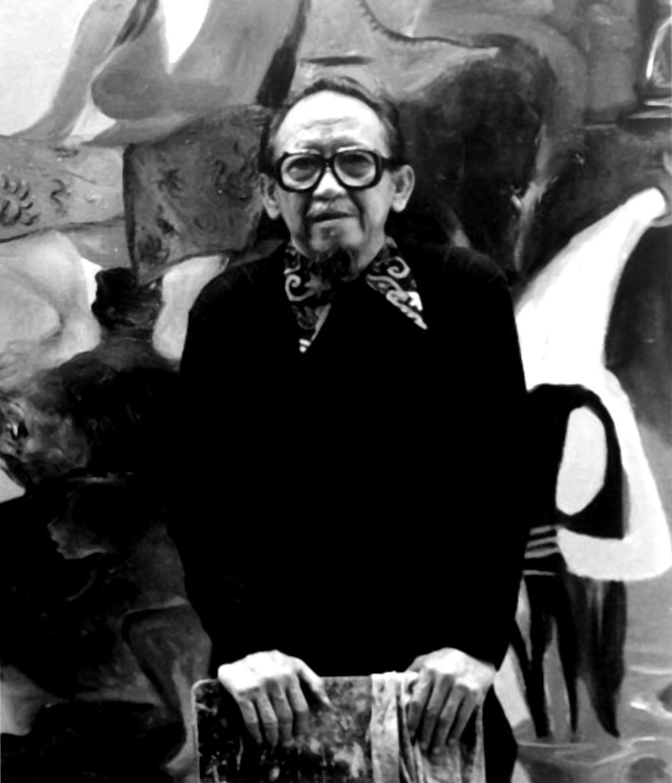
Hendra Gunawan in his studio, 1979.
Ciputra Artpreneur.
HENDRA GUNAWAN
Hendra Gunawan (born in Bandung, June 11, 1918) emerged in the nation’s art scene around the 1930s in the city of Bandung. He developed a strong friendship with Affandi, Wahdi, Barli, and Sudarso. At first, Hendra wanted to learn from Abdullah Suriosubroto, a famous naturalist painter of the time, but then he decided to learn from his comrades. He learned to paint landscapes through Wahdi and learn to paint forms from Affandi. As experienced by Affandi, Hendra’s painting took the attention of Syafe’I Soemardja, an Indonesian scholar with a European education background who later became his supporter in expanding knowledge of painting. During his time living in Bandung, Hendra and friends went in and out of villages in search of objects to draw.
PELUKIS FRONT
During the Japanese expansion in 1940s, Hendra joined Poetera (Center of People’s Power). When the revolution broke out in August, Hendra join the Pelukis Front (Painter’s Front) with comrades such as Barli, Abedy, Sudjana Kerton, and Turkandi who actively captured the war scene. This group held exhibitions in Tasikmalaya and Jogjakarta. Since then, Hendra resided there. In the same city, in 1947, after he pulled out from SIM (Indonesian Young Artists), Hendra and Affandi established their own group, the People’s Painter who later actively held exhibitions. In 1948, this group held a modern sculpture exhibition that later become an important event in Indonesian art history.
HENDRA’S FIRST EXHIBITION
A Year after the nation’s independence, Hendra had his first solo exhibition in the Indonesian National commitee building, Jogjakarta, showing paintings with themes of revolution. Since this exhibition, Hendra’s career as a painter and sculptor started gaining recognition. In the same city, Hendra finished his first sculpture of the Indonesian general, Soedirman. In 1950s, he initiated the founding of Akademi Seni Rupa Indonesia (ASRI/ Art Academy of Indonesia) with other comrades such as R.J. Katamsi, Djajengasmoro, and Kusnadi.
LEKRA
Ten years later, he got his second solo exhibition held in a pavilion of the Des Indes Hotel, Jakarta. In 1962, he went back to Bandung and was assigned as the Head of West Java’s LEKRA and later founded a sanggar (workshop) in Pabaki street. Besides painting, Hendra is an active figure in traditional art activity such as Sundanese dance and Wayang Golek.
KEBON WARU PRISON
Entering the 1960s, LEKRA grew rapidly. In July 1962, Hendra and other LEKRA’s figures founded the University of People’s Art in Bandung that was built to rival ITB’s Fine Art faculty that was frequently condemned for its western-centered ideas. As the university started to develop, the famous G30S-PKI occured and Hendra was arrested. Hendra was imprisoned for 12 years in Kebon Waru Jail, Bandung, and relocated to Bali after he was released in 1978.
FINAL DAYS
Towards his final days, Hendra was ill with diarrhea, ulcer, and heart problems. After refusing to be hospitalized, he spent his last days in the hospital of Sanglah, Bali. A painter who was also a member of the pre-election constituent in 1955 passed away in July 17, 1983.
HENDRA GUNAWAN PAINTINGS: EARLY PERIOD
Like many of his peers during the revolutionary period of Indonesia, Hendra Gunawan paints with a bleak mood, using darker colors to illustrate daily lives.
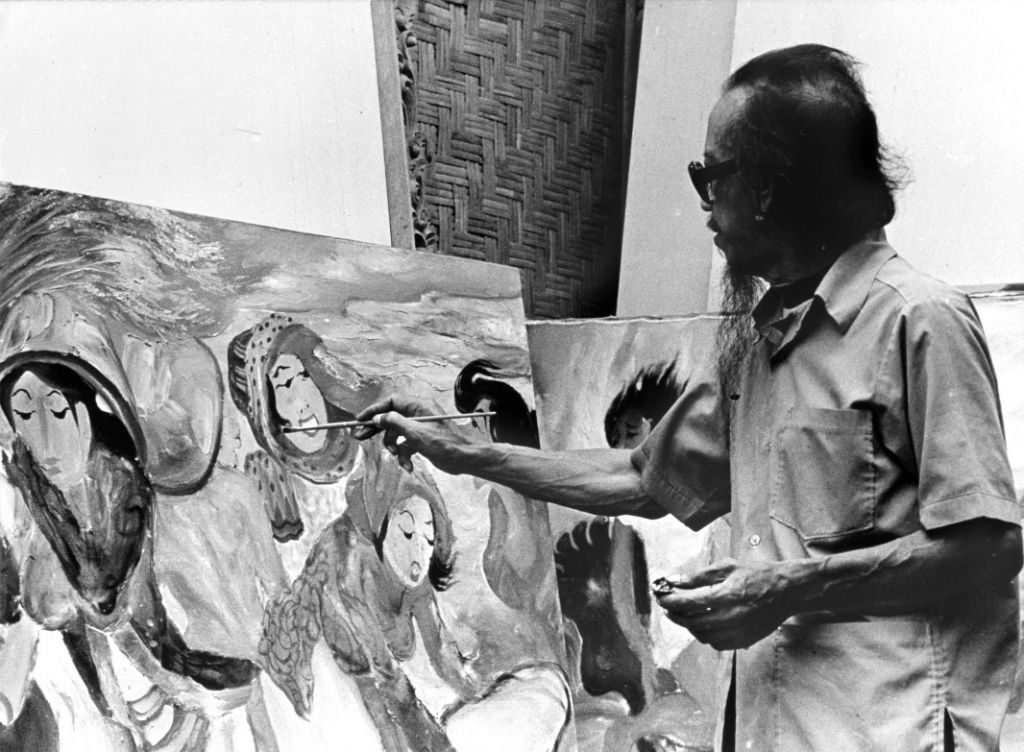
Hendra Gunawan painting “Panen Padi II” (Harvesting rice II).
Ciputra Artpreneur.
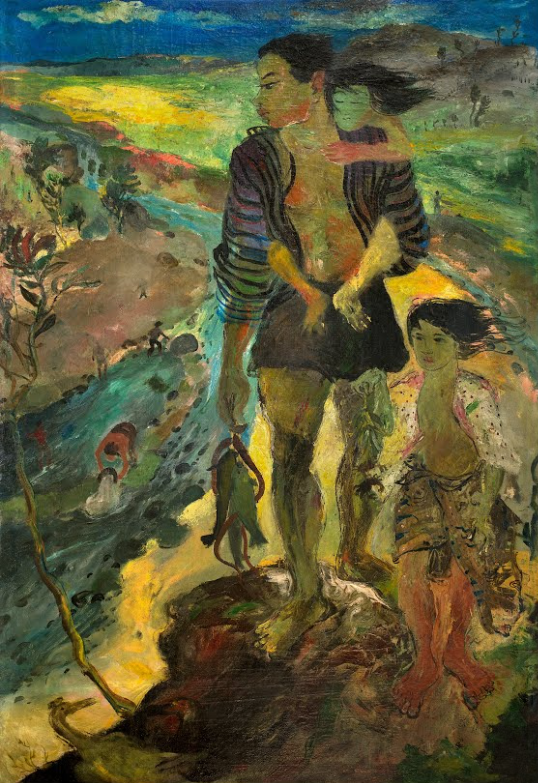
Hendra Gunawan, Return from fishing, 1960.
Ciputra Artpreneur.
Return from fishing
The painting “Return from Fishing”, also known as “Fish Catching”, depicts modest family life in Indonesia, an increasingly rare scene in modern life. This painting was part of a group exhibition called, “Pelukis Rakyat” in 1955, that highlighted Hendra’s talent for capturing daily life using a distinctive aesthetic approach.
HENDRA GUNAWAN PAINTINGS: PRISON PERIOD (1965-1978)
In jail, Hendra met two persons that changed his style of paintings forever. Nuraeni Hendra, his second wife who inspired colours in his paintings, and Syafe’i Soemardja, an Indonesian scholar and artist, educated in Netherlands, who influenced Hendra to paint in a western-style of distortion in figures.
My wife and I, at the second bell
The painting “My Wife and I, at the Second Bell”, depicts Hendra Gunawan hugging his wife Karmini tightly with a glimpse of jail bars in the background. This scene was created during Hendra’s period as a political prisoner.
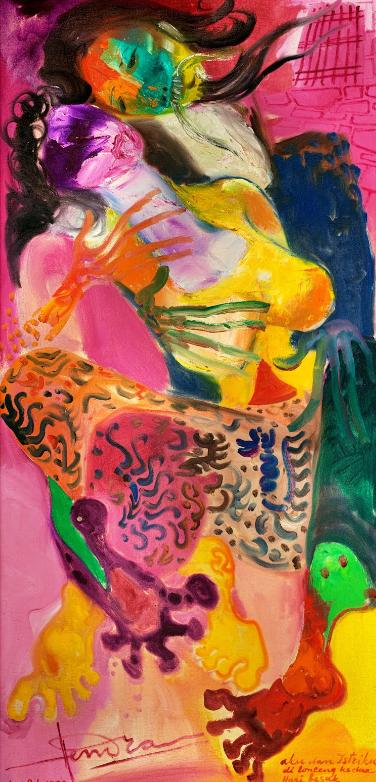
Hendra Gunawan.
My wife and I, at the second bell. 1973.
Ciputra Artpreneur.
A mother’s sacrifice
This painting titled “A Mother’s Sacrifice” evokes Hendra’s precedent-setting painting, “Penjual Ayam”, which received good reviews from art critics in the 1950s. The composition captures a moment in the life of the common people as they struggle through hardship, with the color blue forming an ambient atmosphere and mood.
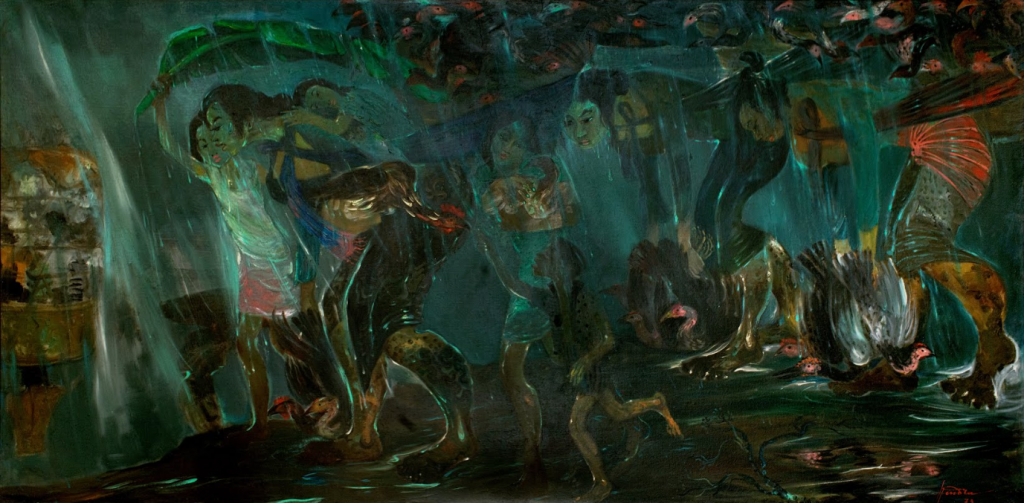
Hendra Gunawan. A mother’s sacrifice. 1973.
Ciputra Artpreneur.
Lake view II
Through this painting, “Lake View II”, Hendra expresses his fascination with Indonesia’s beautiful landscapes.
“I am just a village boy, who has grown up surrounded by splendid nature and agrarian life. This land is a community of stunning vistas of undulating green foothills covered with rice paddies, all of which is crystallized in the beauty of my painting: the beauty of the agrarian life”
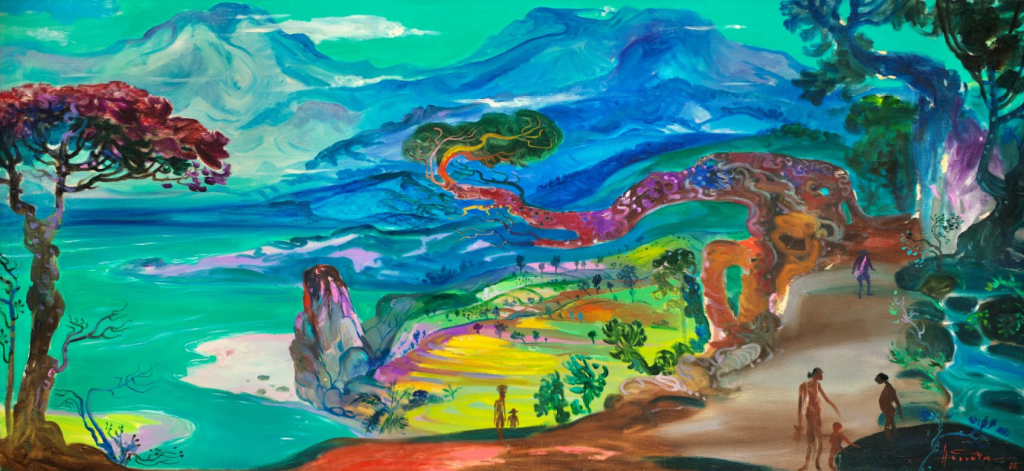
Hendra Gunawan. Lake view II. 1974.
Ciputra Artpreneur.
12 Years Without Bathing
A Self-portrait,
“12 Years Without Bathing”, shows Hendra’s condition during his time in prison. Captivity is often associated with suffering. But for Hendra, even when he is in prison, his body caged, his mind and creativity still grows. Hendra’s growth was supported by his being allowed to paint behind bars, and even teach painting to whoever was willing to learn from him. An important factor that should be noted from this period is the change of color choices in Hendra’s painting. Dark, gloomy colors transformed into bright and vibrant colors. These color choices are believed to be influenced by Nuraeni’s paintings, Hendra Gunawan’s second wife, whom he met in prison.

Hendra Gunawan.
12 years without bathing. 1977.
Ciputra Artpreneur.
HENDRA GUNAWAN PAINTINGS: AFTER PRISON PERIOD (1978 – 1983)
After prison, Hendra spent some time in Jakarta and Bandung. It was his most productive years. He was ordained as the most skilled Front Revolution painter ever, by Adam Malik, the former Vice President of Indonesia. Due to failing health condition, he spent his last years in solitude in Bali.
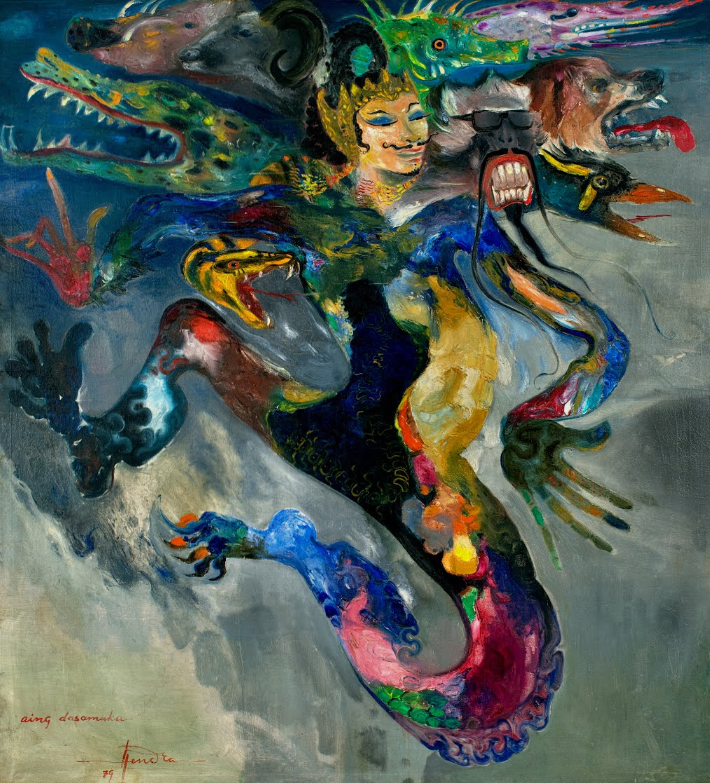
Hendra Gunawan. My ten faces. 1979.
Ciputra Artpreneur.
My Ten Faces
This work was made after Hendra was released from prison as a political prisoner. “Aing Dasamuka” (the indonesian title, written in Sundanese language) can be interpreted as “10 faces”, or “10 mouths”. The strong bond between Hendra and the cultural tradition of wayang showed in this painting, associated with the character Rahwana from the play Rama and Shinta, also known by the name of Dasamuka.
The Painting Estuary Flower is a visualization of these immortal words. After spending hours or days at sea, the fisherman returns to land, going through the same experiences over and over, life events that never stop being missed. “To you my flower my soul finds heaven”, say his man in calm weather. In the year this work was made, Hendra reaffirmed his position in being one of Indonesia’s noted artists. After the years of captivity, his work became bolder following his first solo exhibition in 1979. “Only to his wife and children will a husband and father be anchored. A man’s soul will only find peace within his family”
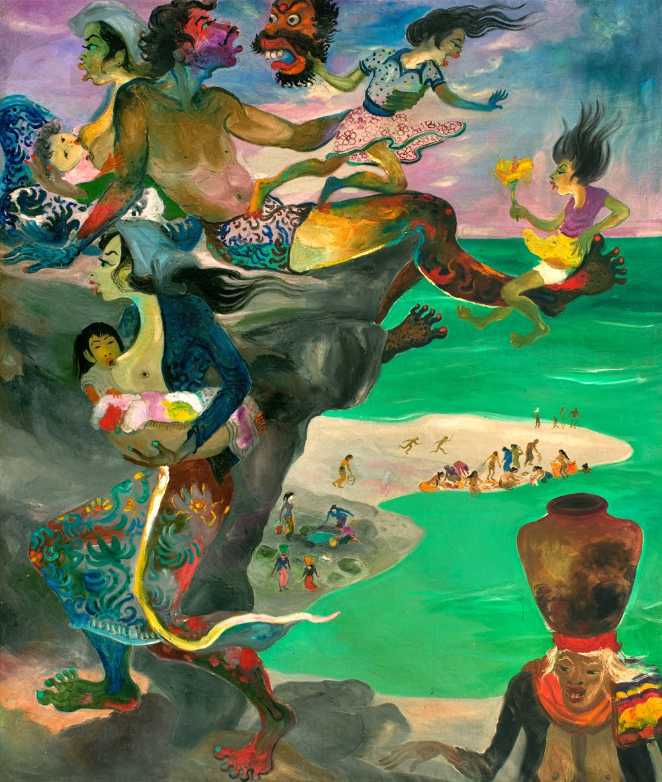
Hendra Gunawan. Estuary flower. 1979.
Ciputra Artpreneur.
In Grooming while nursing, the female characters exist in their daily activities, in their most relaxed moments in the role of a mother. A few experts observe that the women playing the role of mother in Hendra’s paintings are heavily influenced by memories of his mother, who was a significant influence in his life. The women figures are always depicted as having a multiplicity of roles that illustrate strength and bravery, but also grace and nurturing.
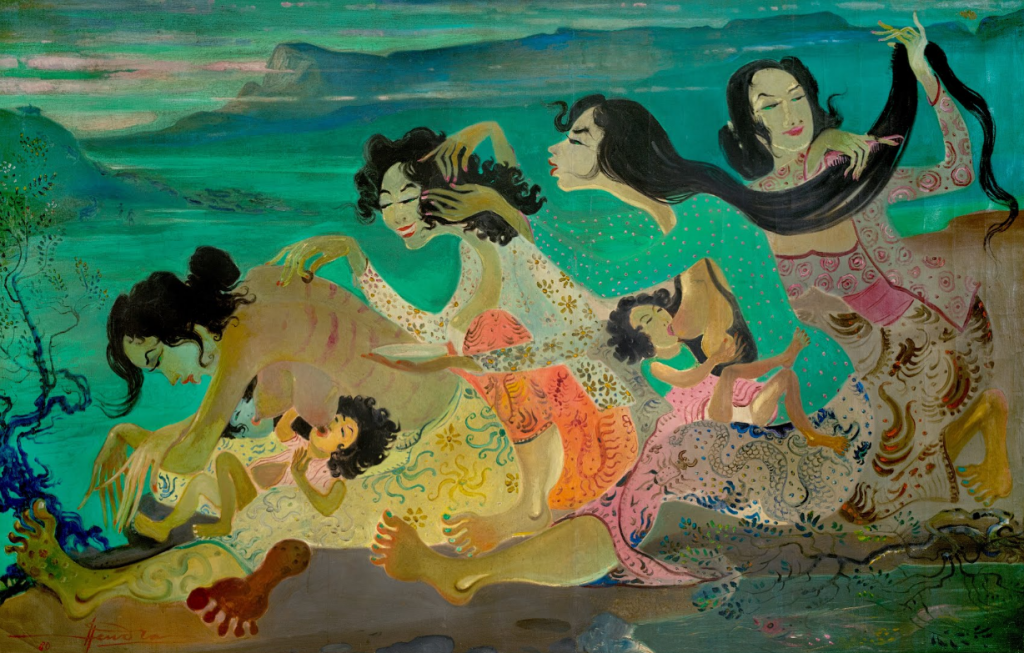
Hendra Gunawan. Grooming while nursing. 1980.
Ciputra Artpreneur.
Diponegoro Wounded at War
This colossal painting depicts a scene from the hostile Java War (1825-1830), one of the most well-known battles of the colonial period. This war cost 20 million Gulden, with hundreds of thousands of victims on both sides, in which half of Jogja’s population died. The unfinished Diponegoro figure in this painting inspires multiple interpretations. Some have said the unfinished painting refers to the unfinished struggle of Diponegoro that is passed to the next generation. The Dutch won the war and arrested the oldest son of Sultan Hamengkubuwono III, yet the painting still inspires strong patriotic feelings.

Hendra Gunawan. Diponegoro wounded at war. 1982.
Ciputra Artpreneur.
Conclusion
Hendra Gunawan is credited as one of the artist who records Indonesia’s past events, through his paintings. Like his works, he had a colorful life translated into the use of tropical colors. His works can now be found in the homes of prominent collectors all over the world.
Source: Google Arts & Culture







